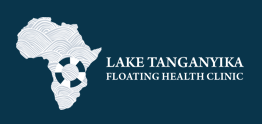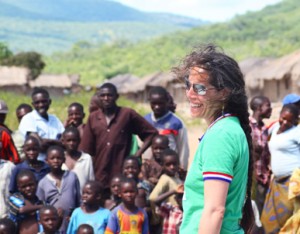by Danielle Shapiro
 Amy Lehman is working furiously to build a floating hospital that will bring medical care to millions of hard-to-reach people in Congo. Danielle Shapiro reports from the water.
Amy Lehman is working furiously to build a floating hospital that will bring medical care to millions of hard-to-reach people in Congo. Danielle Shapiro reports from the water.
On a baking hot day this past October when Amy Lehman set out on eastern Africa’s Lake Tanganyika, the frustrations started early. She was in the region to deliver 15,000 mosquito bed nets to several Congolese villages along the lake’s mountainous shores. Here malaria is rampant and the population’s isolation and poverty is nearly complete.
But she remained unfazed because as she put it, she “loves going and doing the hardest thing.” And in starting her nonprofit, the Lake Tanganyika Floating Health Clinic, three years ago, Lehman, 37, may have found just that.
Her outreach was one of several she’s been conducting with the LTFHC as she raises money to build a hospital boat—complete with operating rooms, an intensive-care unit, a green roof, and telecommunications—that will traverse the lake. The vessel will bring much-needed medical care to the 3 million people living along its shores in Congo, Tanzania, Burundi, and Zambia.
Lehman’s goal is to use the region’s lifeline, the lake, to bring a high-level hospital to villagers rather than those villagers having to get there themselves. Such a journey is nearly impossible for many in an area where roads, electricity, running water, and even access to municipal services are scarce. Once built, the boat’s staff will also provide training for local health-care workers.
It won’t be an easy endeavor to pull off. But Lehman didn’t come to this work on a whim. She’d seen the desperate state here on vacation about four years ago. Juxtaposed with the millions of dollars spent to save patients who had already lived full lives at the University of Chicago, where Lehman was a cardio-thoracic surgery resident, the disparity troubled her. She knew what she could do with such money on Lake Tanganyika. Health problems of her own, which made her job physically difficult to do, pushed her further.
That Lehman is deeply committed to her work is obvious—she wears a map of the lake as a tattoo on her back.
“It wasn’t like I was quitting,” she said of her decision to start the LTFHC and leave her residency. “I am going to do this.”
By 7 a.m. that day in Moba, a port town where Lehman stayed before heading out to the lake for a delivery of bed nets, her bags were packed. But several on her team were inexplicably late to meet and head to the port. When the group did assemble and arrive at the Lengwe, a 200-ton cargo ship she leased for the three-day trip south along the remote coastline, the soccer balls she was to deliver with the nets still hadn’t been loaded.
The weather was clear early, but it can turn ugly quickly on the 420-mile long lake, the world’s longest and second deepest. As the hours passed, Lehman worried about their increasingly late start—she’d been shipwrecked on these waters before. Finally, the owner of a second boat that was to bring some of Lehman’s Congolese team members back north after the delivery decided not to allow his boat to go. She couldn’t leave without a way for her team to get home.
It was time for a break and a beer.
“It’s the usual chain-jerking that goes on here all the time. Our chain is just being jerked to the nth degree,” said Lehman, while sipping a cool Balimi Extra, her waist-length salt-and-pepper hair pulled into a messy bun. And though tired, she was not surprised nor was her sense of humor gone. Her laugh still boomed and her smile remained wide. “I have flashes of anger, but it goes away.”
Having at last loaded the soccer balls and secured another boat to carry her Congolese colleagues home, Lehman and the Lengwe set off, five hours later than planned.
The first stop was Liombe, a village about an hour south of the Moba port. Here, like most villages along the shore, life moves slowly. Children wear raggedy T-shirts and dresses when not wading into the lake, splashing and playing. Often, women launder clothes and dishes nearby. Fishing boats with broad sails made from used plastic work the waters starting as early as the sun.
Villagers came out en masse from their grass-roof huts when the Lengwe arrived.
“Well I think we can say no one has ever done this before!” Lehman said, as she watched local men and even groups of small children lugging the bed nets to shore.
Few organizations, and especially not an individual working alone, have accomplished a bed-net delivery in Congo like this before. For most, the lakeside area is too remote; the delivery too logistically complicated.
Lisa Goldman, a strategic adviser for Sumitomo Chemicals, the company that developed the technology for the Olyset bed nets that Lehman distributed, praised her laser-like focus on the Lake Tanganyika basin.
“There are millions of bed nets that need to be distributed in the Congo. On a numerical level, it’s a start not an end,” she said. “But the way she distributed these nets and the level of commitment and the particular community, the lakeside community, makes it more important because normally these are the last people to get anything.”
But the need is great. Malaria is the leading cause of death and illness in Congo, a vast central African nation of about 70 million. Nearly 95 percent of the population lives in malaria endemic areas and children are especially at risk. Together, Congo and Nigeria account for about 40 percent of malaria cases and deaths in Sub-Saharan Africa each year, according to the World Health Organization.
In conjunction with this Congo delivery, Lehman has brought 30,000 mosquito nets to villages along the Tanzanian coast. Her next project on women’s reproductive health will be in Tanzania, too. The outreach this spring will include surgeries to repair fistulas, or tears between the bladder and/or rectum and the vagina, usually resulting from obstructed labor.
Lehman says she was well aware that the practicalities of working in these remote areas, especially in a conflict-torn nation like Congo, would create headaches. But she was undeterred.
“If you decide that you are going to do something that’s trailblazing, you’re stuck,” she said. “You have to have your steeled guts.”
That steeliness has been tested nearly every step of the way as she builds her organization. But those who know her best call Lehman a “force of nature.” Joel Frushone, a consultant and specialist in African governmental relations who Lehman hired, said she is uniquely “smart enough and crazy enough to pull this off.”
Lehman needs to raise roughly $6 million just to build the boat, though she says she hates asking people for money. So far she’s raised about $795,000, the majority of which has been used for direct services. Lehman said she has spent most of her disposable cash on this project, it is her full-time job, and yet she has earned no money herself.
Though she’s found a Tanzanian ship-builder to fashion the vessel, she still need plans drawn and $100,000 to pay for them. Once the boat is built and she’s gotten it to the lake, she’ll have to reliably stock and refuel it though there are only a few ports to do so.
She has had to meet with, and win over, officials from all four nations bordering the lake and has had to familiarize herself with an array of cultures. She has already tackled shipping, customs, and immigration nightmares and has been steadily building local teams of translators and fixers. Just getting to the lake can require thousands of dollars, chartered flights, and sometimes days-long car rides on pot-holed dirt roads.
Yet, when it comes to confronting challenges, Lehman has practice. As a child she struggled with an autoimmune disease, spending many years at home in a wheelchair. As a result she’s had severe nerve damage in her right arm that threatened her career as a cardio-thoracic surgeon. A single mother, Lehman got pregnant in college. She then finished her medical and business degrees at the University of Chicago while raising her son alone.
“I love chest surgery. No joke,” she said. But the nerve damage makes operating practically impossible. “When I think about what else I could do that would keep me as compelled, it’s this.”
Frushone and Lehman say the LTFHC aims to build sustainable infrastructure throughout the lake basin for medical care, supply chains and communications as much as it focuses on ameliorating the severe health burden caused by malaria, malnutrition, and maternal and infant mortality, among other things.
“This is going to fill a gap that no one else would fill,” Frushone said.
That Lehman is deeply committed to her work is obvious—she wears a map of the lake as a tattoo on her back. It is one of nine she has on her legs, arms, and chest.
“You saw her tattoo, she’s all in,” said Damien Drake, the director of photography on a documentary that award-winning filmmakers Fisher Stevens and Mark Monroe are making about Lehman. “There’s no not getting this done. She’ll die getting this done, more so than anyone I’ve met.”
When asked what he hopes the documentary will convey, Drake, a partner at the film company East Pleasant, did not hesitate: “to show that anything is possible,” he said.




